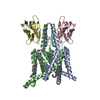[English] 日本語
 Yorodumi
Yorodumi- PDB-8qz4: Crystal structure of human two pore domain potassium ion channel ... -
+ Open data
Open data
- Basic information
Basic information
| Entry | Database: PDB / ID: 8qz4 | |||||||||||||||||||||||||||
|---|---|---|---|---|---|---|---|---|---|---|---|---|---|---|---|---|---|---|---|---|---|---|---|---|---|---|---|---|
| Title | Crystal structure of human two pore domain potassium ion channel TREK-2 (K2P10.1) in complex with an activatory nanobody (Nb76) | |||||||||||||||||||||||||||
 Components Components |
| |||||||||||||||||||||||||||
 Keywords Keywords | MEMBRANE PROTEIN / Potassium ion channel / Nanobody / Structural Genomics / Structural Genomics Consortium / SGC | |||||||||||||||||||||||||||
| Function / homology |  Function and homology information Function and homology informationTWIK related potassium channel (TREK) / cellular response to arachidonate / mechanosensitive potassium channel activity / Phase 4 - resting membrane potential / potassium ion leak channel activity / outward rectifier potassium channel activity / monoatomic ion channel complex / potassium channel activity / potassium ion transmembrane transport / signal transduction / plasma membrane Similarity search - Function | |||||||||||||||||||||||||||
| Biological species |  Homo sapiens (human) Homo sapiens (human) | |||||||||||||||||||||||||||
| Method |  X-RAY DIFFRACTION / X-RAY DIFFRACTION /  SYNCHROTRON / SYNCHROTRON /  MOLECULAR REPLACEMENT / Resolution: 3.2 Å MOLECULAR REPLACEMENT / Resolution: 3.2 Å | |||||||||||||||||||||||||||
 Authors Authors | Rodstrom, K.E.J. / Pike, A.C.W. / Baronina, A. / Ang, J. / Bushell, S.R. / Chalk, R. / Mukhopadhyay, S.M.M. / Pardon, E. / Arrowsmith, C.H. / Edwards, A.M. ...Rodstrom, K.E.J. / Pike, A.C.W. / Baronina, A. / Ang, J. / Bushell, S.R. / Chalk, R. / Mukhopadhyay, S.M.M. / Pardon, E. / Arrowsmith, C.H. / Edwards, A.M. / Bountra, C. / Burgess-Brown, N.A. / Tucker, S.J. / Steyaert, J. / Carpenter, E.P. / Structural Genomics Consortium (SGC) | |||||||||||||||||||||||||||
| Funding support |  United Kingdom, United Kingdom,  France, France,  Belgium, 8items Belgium, 8items
| |||||||||||||||||||||||||||
 Citation Citation |  Journal: Nat Commun / Year: 2024 Journal: Nat Commun / Year: 2024Title: Extracellular modulation of TREK-2 activity with nanobodies provides insight into the mechanisms of K2P channel regulation. Authors: Karin E J Rödström / Alexander Cloake / Janina Sörmann / Agnese Baronina / Kathryn H M Smith / Ashley C W Pike / Jackie Ang / Peter Proks / Marcus Schewe / Ingelise Holland-Kaye / Simon R ...Authors: Karin E J Rödström / Alexander Cloake / Janina Sörmann / Agnese Baronina / Kathryn H M Smith / Ashley C W Pike / Jackie Ang / Peter Proks / Marcus Schewe / Ingelise Holland-Kaye / Simon R Bushell / Jenna Elliott / Els Pardon / Thomas Baukrowitz / Raymond J Owens / Simon Newstead / Jan Steyaert / Elisabeth P Carpenter / Stephen J Tucker /    Abstract: Potassium channels of the Two-Pore Domain (K2P) subfamily, KCNK1-KCNK18, play crucial roles in controlling the electrical activity of many different cell types and represent attractive therapeutic ...Potassium channels of the Two-Pore Domain (K2P) subfamily, KCNK1-KCNK18, play crucial roles in controlling the electrical activity of many different cell types and represent attractive therapeutic targets. However, the identification of highly selective small molecule drugs against these channels has been challenging due to the high degree of structural and functional conservation that exists not only between K2P channels, but across the whole K channel superfamily. To address the issue of selectivity, here we generate camelid antibody fragments (nanobodies) against the TREK-2 (KCNK10) K2P K channel and identify selective binders including several that directly modulate channel activity. X-ray crystallography and CryoEM data of these nanobodies in complex with TREK-2 also reveal insights into their mechanisms of activation and inhibition via binding to the extracellular loops and Cap domain, as well as their suitability for immunodetection. These structures facilitate design of a biparatropic inhibitory nanobody with markedly improved sensitivity. Together, these results provide important insights into TREK channel gating and provide an alternative, more selective approach to modulation of K2P channel activity via their extracellular domains. | |||||||||||||||||||||||||||
| History |
|
- Structure visualization
Structure visualization
| Structure viewer | Molecule:  Molmil Molmil Jmol/JSmol Jmol/JSmol |
|---|
- Downloads & links
Downloads & links
- Download
Download
| PDBx/mmCIF format |  8qz4.cif.gz 8qz4.cif.gz | 290.5 KB | Display |  PDBx/mmCIF format PDBx/mmCIF format |
|---|---|---|---|---|
| PDB format |  pdb8qz4.ent.gz pdb8qz4.ent.gz | 234.5 KB | Display |  PDB format PDB format |
| PDBx/mmJSON format |  8qz4.json.gz 8qz4.json.gz | Tree view |  PDBx/mmJSON format PDBx/mmJSON format | |
| Others |  Other downloads Other downloads |
-Validation report
| Summary document |  8qz4_validation.pdf.gz 8qz4_validation.pdf.gz | 1 MB | Display |  wwPDB validaton report wwPDB validaton report |
|---|---|---|---|---|
| Full document |  8qz4_full_validation.pdf.gz 8qz4_full_validation.pdf.gz | 1 MB | Display | |
| Data in XML |  8qz4_validation.xml.gz 8qz4_validation.xml.gz | 25.4 KB | Display | |
| Data in CIF |  8qz4_validation.cif.gz 8qz4_validation.cif.gz | 34.5 KB | Display | |
| Arichive directory |  https://data.pdbj.org/pub/pdb/validation_reports/qz/8qz4 https://data.pdbj.org/pub/pdb/validation_reports/qz/8qz4 ftp://data.pdbj.org/pub/pdb/validation_reports/qz/8qz4 ftp://data.pdbj.org/pub/pdb/validation_reports/qz/8qz4 | HTTPS FTP |
-Related structure data
| Related structure data |  8qz1C  8qz2C  8qz3C C: citing same article ( |
|---|---|
| Similar structure data | Similarity search - Function & homology  F&H Search F&H Search |
- Links
Links
- Assembly
Assembly
| Deposited unit | 
| ||||||||
|---|---|---|---|---|---|---|---|---|---|
| 1 |
| ||||||||
| Unit cell |
|
- Components
Components
| #1: Protein | Mass: 31060.111 Da / Num. of mol.: 2 Source method: isolated from a genetically manipulated source Source: (gene. exp.)  Homo sapiens (human) / Gene: KCNK10, TREK2 / Plasmid: pFB-CT10HF-LIC / Cell line (production host): Sf9 / Production host: Homo sapiens (human) / Gene: KCNK10, TREK2 / Plasmid: pFB-CT10HF-LIC / Cell line (production host): Sf9 / Production host:  #2: Antibody | Mass: 13648.158 Da / Num. of mol.: 2 Source method: isolated from a genetically manipulated source Source: (gene. exp.)   #3: Chemical | ChemComp-BA / #4: Chemical | ChemComp-Y01 / #5: Water | ChemComp-HOH / | Has ligand of interest | N | Has protein modification | Y | |
|---|
-Experimental details
-Experiment
| Experiment | Method:  X-RAY DIFFRACTION / Number of used crystals: 1 X-RAY DIFFRACTION / Number of used crystals: 1 |
|---|
- Sample preparation
Sample preparation
| Crystal | Density Matthews: 3.74 Å3/Da / Density % sol: 67.17 % |
|---|---|
| Crystal grow | Temperature: 277 K / Method: vapor diffusion, sitting drop / pH: 7 Details: 0.1 M HEPES pH 7.0, 0.3 M BaCl2, 39% polyethylene glycol 400 |
-Data collection
| Diffraction | Mean temperature: 100 K / Serial crystal experiment: N |
|---|---|
| Diffraction source | Source:  SYNCHROTRON / Site: SYNCHROTRON / Site:  Diamond Diamond  / Beamline: I24 / Wavelength: 0.9687 Å / Beamline: I24 / Wavelength: 0.9687 Å |
| Detector | Type: DECTRIS PILATUS3 6M / Detector: PIXEL / Date: Jul 2, 2017 |
| Radiation | Monochromator: M / Protocol: SINGLE WAVELENGTH / Monochromatic (M) / Laue (L): M / Scattering type: x-ray |
| Radiation wavelength | Wavelength: 0.9687 Å / Relative weight: 1 |
| Reflection | Resolution: 3.203→51.83 Å / Num. obs: 17904 / % possible obs: 77.9 % / Redundancy: 4 % / CC1/2: 0.998 / Rpim(I) all: 0.066 / Rrim(I) all: 0.134 / Net I/σ(I): 8.4 |
| Reflection shell | Resolution: 3.203→3.336 Å / Redundancy: 4 % / Mean I/σ(I) obs: 1.7 / Num. unique obs: 892 / CC1/2: 0.615 / Rpim(I) all: 0.522 / Rrim(I) all: 1.065 / % possible all: 34.4 |
- Processing
Processing
| Software |
| |||||||||||||||||||||||||||||||||||||||||||||||||||||||||||||||||||||||||||||||||||||||||||||||||||||||||||||||||||||||||||||
|---|---|---|---|---|---|---|---|---|---|---|---|---|---|---|---|---|---|---|---|---|---|---|---|---|---|---|---|---|---|---|---|---|---|---|---|---|---|---|---|---|---|---|---|---|---|---|---|---|---|---|---|---|---|---|---|---|---|---|---|---|---|---|---|---|---|---|---|---|---|---|---|---|---|---|---|---|---|---|---|---|---|---|---|---|---|---|---|---|---|---|---|---|---|---|---|---|---|---|---|---|---|---|---|---|---|---|---|---|---|---|---|---|---|---|---|---|---|---|---|---|---|---|---|---|---|---|
| Refinement | Method to determine structure:  MOLECULAR REPLACEMENT / Resolution: 3.2→31.11 Å / Cor.coef. Fo:Fc: 0.849 / Cor.coef. Fo:Fc free: 0.804 / Cross valid method: THROUGHOUT / SU Rfree Blow DPI: 0.562 MOLECULAR REPLACEMENT / Resolution: 3.2→31.11 Å / Cor.coef. Fo:Fc: 0.849 / Cor.coef. Fo:Fc free: 0.804 / Cross valid method: THROUGHOUT / SU Rfree Blow DPI: 0.562
| |||||||||||||||||||||||||||||||||||||||||||||||||||||||||||||||||||||||||||||||||||||||||||||||||||||||||||||||||||||||||||||
| Displacement parameters | Biso mean: 77.01 Å2
| |||||||||||||||||||||||||||||||||||||||||||||||||||||||||||||||||||||||||||||||||||||||||||||||||||||||||||||||||||||||||||||
| Refine analyze | Luzzati coordinate error obs: 0.56 Å | |||||||||||||||||||||||||||||||||||||||||||||||||||||||||||||||||||||||||||||||||||||||||||||||||||||||||||||||||||||||||||||
| Refinement step | Cycle: LAST / Resolution: 3.2→31.11 Å
| |||||||||||||||||||||||||||||||||||||||||||||||||||||||||||||||||||||||||||||||||||||||||||||||||||||||||||||||||||||||||||||
| Refine LS restraints |
| |||||||||||||||||||||||||||||||||||||||||||||||||||||||||||||||||||||||||||||||||||||||||||||||||||||||||||||||||||||||||||||
| LS refinement shell | Resolution: 3.2→3.26 Å
| |||||||||||||||||||||||||||||||||||||||||||||||||||||||||||||||||||||||||||||||||||||||||||||||||||||||||||||||||||||||||||||
| Refinement TLS params. | Method: refined / Refine-ID: X-RAY DIFFRACTION
| |||||||||||||||||||||||||||||||||||||||||||||||||||||||||||||||||||||||||||||||||||||||||||||||||||||||||||||||||||||||||||||
| Refinement TLS group |
|
 Movie
Movie Controller
Controller



 PDBj
PDBj









